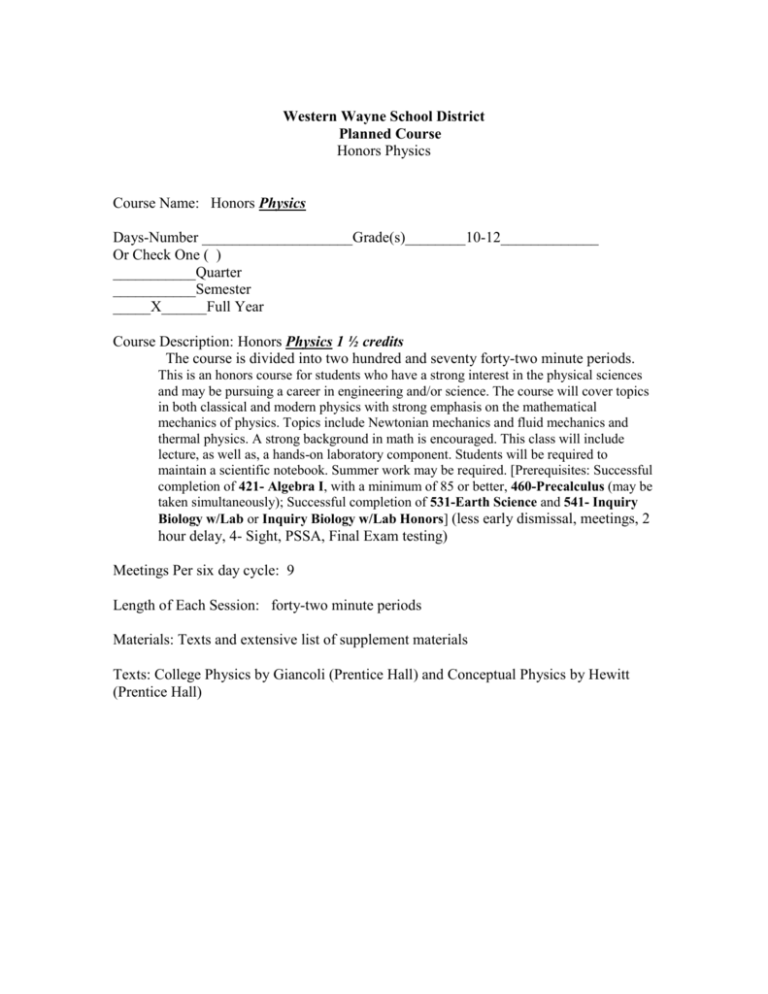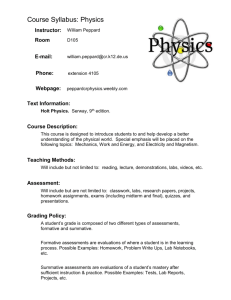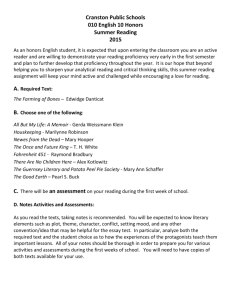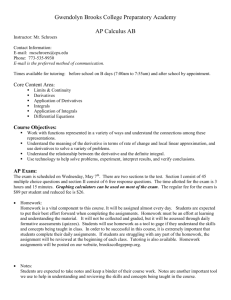honorphysicsmap (2)
advertisement

Western Wayne School District Planned Course Honors Physics Course Name: Honors Physics Days-Number ____________________Grade(s)________10-12_____________ Or Check One ( ) ___________Quarter ___________Semester _____X______Full Year Course Description: Honors Physics 1 ½ credits The course is divided into two hundred and seventy forty-two minute periods. This is an honors course for students who have a strong interest in the physical sciences and may be pursuing a career in engineering and/or science. The course will cover topics in both classical and modern physics with strong emphasis on the mathematical mechanics of physics. Topics include Newtonian mechanics and fluid mechanics and thermal physics. A strong background in math is encouraged. This class will include lecture, as well as, a hands-on laboratory component. Students will be required to maintain a scientific notebook. Summer work may be required. [Prerequisites: Successful completion of 421- Algebra I, with a minimum of 85 or better, 460-Precalculus (may be taken simultaneously); Successful completion of 531-Earth Science and 541- Inquiry Biology w/Lab or Inquiry Biology w/Lab Honors] (less early dismissal, meetings, 2 hour delay, 4- Sight, PSSA, Final Exam testing) Meetings Per six day cycle: 9 Length of Each Session: forty-two minute periods Materials: Texts and extensive list of supplement materials Texts: College Physics by Giancoli (Prentice Hall) and Conceptual Physics by Hewitt (Prentice Hall) Western Wayne School District Planned Course Overview Course Name: Honors Physics Grade: 10-12 Check one ( ) _____Quarter _____Semester Standards Categories ____X_ Full Year Time (Periods) Topics include Newtonian mechanics and fluid mechanics and thermal physics. 235 3.2.12.B1: Analyze the principles of rotational motion to solve problems relating to angular momentum and torque. 3.2.12.B2: Explain how energy flowing through an open system can be lost. Demonstrate how the law of conservation of momentum and conservation of energy provide alternate approaches to predict and describe the motion of objects. 3.2.12.B3: Describe the relationship between the average kinetic molecular energy, temperature, and phase changes. 3.2.12.B4: Describe conceptually the attractive and repulsive forces between objects relative to their charges and the distance between them. 3.2.12.B5: Research how principles of wave transmissions are used in a wide range of technologies. Research technologies that incorporate principles of wave transmission. 3.2.12.B6: CONSTANCY/CHANGE Compare and contrast motions of objects using forces and conservation laws. 3.2.12.B7: Examine the status of existing theories. Evaluation(s) Teacher Made Assessments Unit Tests Unit quizzes Laboratories Independent Practice Reinforcement Activities Formal Laboratory reports Interactive Notebook Formative Assessments Evaluate experimental information for relevance and adherence to science processes. Judge that conclusions are consistent and logical with experimental conditions. Interpret results of experimental research to predict new information, propose additional investigable questions, or advance a solution. Communicate and defend a scientific argument. 3.2.P.B1: Differentiate among translational motion, simple harmonic motion, and rotational motion in terms of position, velocity, and acceleration. Use force and mass to explain translational motion or simple harmonic motion of objects. Relate torque and rotational inertia to explain rotational motion. 3.2.P.B2: Explain the translation and simple harmonic motion of objects using conservation of energy and conservation of momentum. Describe the rotational motion of objects using the conservation of energy and conservation of angular momentum. Explain how gravitational, electrical, and magnetic forces and torques give rise to rotational motion. 3.2.P.B3: Analyze the factors that influence convection, conduction, and radiation between objects or regions that are at different temperatures. 3.2.P.B4: Explain how stationary and moving particles result in electricity and magnetism. Develop qualitative and quantitative understanding of current, voltage, resistance, and the connections among them. Explain how electrical induction is applied in technology. 3.2.P.B5: Explain how waves transfer energy without transferring matter. Explain how waves carry information from remote sources that can be detected and interpreted. Describe the causes of wave frequency, speed, and wave length. 3.2.P.B6: Use Newton’s laws of motion and gravitation to describe and predict the motion of objects ranging from atoms to the galaxies. 3.2.P.B7: Compare and contrast scientific theories. Know that both direct and indirect observations are used by scientists to study the natural world and universe. Identify questions and concepts that guide scientific investigations. Formulate and revise explanations and models using logic and evidence. Recognize and analyze alternative explanations and models. Explain the importance of accuracy and precision in making valid measurements. Examine the status of existing theories. Evaluate experimental information for relevance and adherence to science processes. Judge that conclusions are consistent and logical with experimental conditions. Interpret results of experimental research to predict new information, propose additional investigable questions, or advance a solution. Communicate and defend a scientific argument. Western Wayne School District Unit Overview Course Name: Honors Physics Grades: 10 - 12 Focus Question: Kinematics Unit How will students describe the motion of an object be in a measurable and quantitative way? Time (Periods) 34 Essential Question Is the student able to describe a frame of reference? Is the student able to define and apply definitions of displacement, average velocity, instantaneous velocity, and average acceleration? Is the student able to demonstrate proficiency in solving problems using kinematics equations, including problems involving free fall by using the value of the acceleration due to gravity? Is the student able to analyze motion graphs qualitatively and quantitatively, including calculations of the slope of the tangent of an x-versus-t graph, the slope of the v-versus-t graph, the area under the v-versus-t graph and the area under the a-versus-t graph? Is the student able to distinguish between vectors and scalars? Is the student able to add vectors using graphical methods: parallelogram and polygon methods? Is the student able to add vectors using the component method of vector addition? Is the student able to describe the horizontal and vertical motion of a projectile? Is the student able to demonstrate proficiency in solving problems of situations involving projectiles fired horizontally and at an angle? Is the student able to apply the concepts of vectors to solve problems involving relative velocity? Western Wayne School District Curriculum Map Grade Level: 10-12 Science Anchor: Evaluations(s) Teacher Made Assessments Unit Tests Unit quizzes Laboratories Independent Practice Reinforcement Activities Formal Laboratory reports Interactive Notebook Formative Assessments Marking Period: Periods of Instruction 34 Instructional Time: Instructional Programming (content/method) The student is able to describe a frame of reference. The student is able to define and apply definitions of displacement, average velocity, instantaneous velocity, and average acceleration. The student is able to demonstrate proficiency in solving problems using kinematics equations, including problems involving free fall by using the value of the acceleration due to gravity. The student is able to analyze motion graphs qualitatively and quantitatively, including calculations of the slope of the tangent of an x-versus-t graph, the slope of the v-versus-t graph, the area under the v-versus-t graph and the area under the a-versus-t graph. The student is able to distinguish between vectors and scalars. The student is able to add vectors using graphical methods: parallelogram and polygon methods. The student is able to add vectors using the component method of vector addition. The student is able to describe the horizontal and vertical motion of a projectile. The student is able to demonstrate proficiency in solving problems of situations involving projectiles fired horizontally and at an angle. The student is able to apply the concepts of vectors to solve problems involving relative velocity. Evaluation Teacher Made Assessments Unit Tests Unit quizzes Laboratories Independent Practice Reinforcement Activities Formal Laboratory reports Interactive Notebook Formative Assessments Western Wayne School District Unit Overview Course Name: Honors Physics Grades: 10 - 12 Focus Question: Newton’s Laws of Motion Unit How will students describe the motion of an object be in a measurable and quantitative way? Time (Periods) 42 Essential Question Is the student able to distinguish between contact forces and field forces by identifying the agent that causes the force ? Is the student able to distinguish between mass and weight, and calculate weight using the acceleration due to gravity ? Is the student able to differentiate between static and kinetic friction ? Is the student able to state and apply Newton’s first law of motion for objects in static equilibrium? Is the student able to demonstrate proficiency in accurately drawing and labeling free-body diagrams? Is the student able to state and apply Newton’s second law of motion? Is the student able to demonstrate proficiency in solving problems that involve objects in motion with constant acceleration by analyzing the resultant force(s) in horizontal surfaces, inclined planes, and pulley systems ? Is the student able to state and apply Newton’s third law of motion ? Evaluations(s) Teacher Made Assessments Unit Tests Unit quizzes Laboratories Independent Practice Reinforcement Activities Formal Laboratory reports Interactive Notebook Formative Assessments Western Wayne School District Curriculum Map Grade Level: 10-12 Marking Period: Periods of Instruction 42 Science Anchor: Instructional Time: Instructional Programming (content/method) The student is able to distinguish between contact forces and field forces by identifying the agent that causes the force . The student is able to distinguish between mass and weight, and calculate weight using the acceleration due to gravity . The student is able to differentiate between static and kinetic friction . The student is able to state and apply Newton’s first law of motion for objects in static equilibrium. The student is able to demonstrate proficiency in accurately drawing and labeling free-body diagrams. The student is able to state and apply Newton’s second law of motion. The student is able to demonstrate proficiency in solving problems that involve objects in motion with constant acceleration by analyzing the resultant force(s) in horizontal surfaces, inclined planes, and pulley systems . The student is able to state and apply Newton’s third law of motion . Western Wayne School District Unit Overview Course Name: Honors Physics Grades: 10 - 12 Evaluation Teacher Made Assessments Unit Tests Unit quizzes Laboratories Independent Practice Reinforcement Activities Formal Laboratory reports Interactive Notebook Formative Assessments Focus Question: Work Energy Power Unit How will students describe the motion of an object be in a measurable and quantitative way? Time (Periods) 23 Essential Question Evaluations(s) Is the student able to define and apply the concepts of work done by a constant force, potential energy, kinetic energy, and power? Is the student able to calculate the work from the area under the curve of a force-versus-displacement graph? Is the student able to distinguish between conservative and nonconservative forces? Is the student able to state and apply the principle of conservation of mechanical energy ? Is the student able to demonstrate proficiency in solving problems by applying the work–energy theorem to situations that involve conservative and nonconservative forces? Western Wayne School District Curriculum Map Grade Level: 10-12 Science Anchor: Teacher Made Assessments Unit Tests Unit quizzes Laboratories Independent Practice Reinforcement Activities Formal Laboratory reports Interactive Notebook Formative Assessments Marking Period: Periods of Instruction 23 Instructional Time: Instructional Programming (content/method) Evaluation The student is able to define and apply the concepts of work done by a constant force, potential energy, kinetic energy, and power. The student is able to calculate the work from the area under the curve of a force-versus-displacement graph. The student is able to distinguish between conservative and nonconservative forces. The student is able to state and apply the principle of conservation of mechanical energy . The student is able to demonstrate proficiency in solving problems by applying the work–energy theorem to situations that involve conservative and nonconservative forces. Teacher Made Assessments Unit Tests Unit quizzes Laboratories Independent Practice Reinforcement Activities Formal Laboratory reports Interactive Notebook Formative Assessments Western Wayne School District Unit Overview Course Name: Honors Physics Grades: 10 - 12 Focus Question: Systems of Particles and Linear Momentum Unit How will students describe the motion of an object be in a measurable and quantitative way? Time (Periods) 19 Essential Question Is the student able to define and give examples of impulse and Evaluations(s) Teacher Made Assessments Unit Tests momentum ? Is the student able to restate Newton’s second law of motion in terms of momentum ? Is the student able to calculate the change in momentum from the area under the curve of a force versus time graph? Is the student able to derive a statement of the conservation of momentum between two objects by applying Newton’s third law? Is the student able to define and recognize examples of elastic and inelastic collisions ? Is the student able to explain which conservation laws apply to each type of collisions? Is the student able to demonstrate proficiency in solving problems involving conservation of momentum in collisions in one and two dimensions? Unit quizzes Laboratories Independent Practice Reinforcement Activities Formal Laboratory reports Interactive Notebook Formative Assessments Western Wayne School District Curriculum Map Grade Level: Marking Period: Periods of Instruction 19 Science Anchor: Instructional Time: Instructional Programming (content/method) Evaluation Teacher Made Assessments Unit Tests The student is able to define and give examples of impulse and momentum . The student is able to restate Newton’s second law of motion in terms of momentum . The student is able to calculate the change in momentum from the area under the curve of a force versus time graph. The student is able to derive a statement of the conservation of momentum between two objects by applying Newton’s third law. The student is able to define and recognize examples of elastic and inelastic collisions . The student is able to explain which conservation laws apply to each type of collisions. The student is able to demonstrate proficiency in solving problems involving conservation of momentum in collisions in one and two dimensions. Unit quizzes Laboratories Independent Practice Reinforcement Activities Formal Laboratory reports Interactive Notebook Formative Assessments Western Wayne School District Unit Overview Course Name: Honors Physics Grades: 10 - 12 Focus Question: Circular Motion and Rotation Unit How will students describe the motion of an object be in a measurable and quantitative way? Time (Periods) 19 Essential Question Is the student able to explain the characteristics of uniform circular motion? Is the student able to derive the equation for centripetal acceleration of an object moving in a circle at constant speed? Evaluations(s) Teacher Made Assessments Unit Tests Unit quizzes Laboratories Is the student able to understand that centripetal force is not a new type of force? Is the student able to understand that centrifugal force does not exist? Is the student able to demonstrate proficiency in solving problems involving banking angles, the conical pendulum and motion in a vertical circle? Is the student able to define and calculate the torque of a given force about an axis of rotation? Is the student able to state the two conditions of equilibrium (translational and rotational) and apply them to solve for unknown forces and/or distances in a variety of situations? Independent Practice Reinforcement Activities Formal Laboratory reports Interactive Notebook Formative Assessments Western Wayne School District Curriculum Map Grade Level: Marking Period: Periods of Instruction Science Anchor: Instructional Time: Instructional Programming (content/method) 19 The student is able to explain the characteristics of uniform circular motion. The student is able to derive the equation for centripetal acceleration of Evaluation Teacher Made Assessments Unit Tests Unit quizzes Laboratories Independent Practice an object moving in a circle at constant speed. The student is able to understand that centripetal force is not a new type of force. The student is able to understand that centrifugal force does not exist. The student is able to demonstrate proficiency in solving problems involving banking angles, the conical pendulum and motion in a vertical circle. The student is able to define and calculate the torque of a given force about an axis of rotation. The student is able to state the two conditions of equilibrium (translational and rotational) and apply them to solve for unknown forces and/or distances in a variety of situations. Reinforcement Activities Formal Laboratory reports Interactive Notebook Formative Assessments Western Wayne School District Unit Overview Course Name: Honors Physics Grades: 10 - 12 Focus Question: Oscillations and Gravitation Unit How will students describe the motion of an object be in a measurable and quantitative way? Time Essential Question Evaluations(s) (Periods) 28 Is the student able to define and identify the following terms on a displacement-versus-time graph: equilibrium position, amplitude, period, and frequency? Is the student able to define simple harmonic motion? Is the student able to use the reference circle to describe the displacement, velocity and acceleration? Is the student able to describe and apply Hooke’s law and Newton’s second law to determine the acceleration as a function of displacement? Teacher Made Assessments Unit Tests Unit quizzes Laboratories Independent Practice Reinforcement Activities Formal Laboratory reports Interactive Notebook Formative Assessments Is the student able to apply the principles of conservation of mechanical energy for an object moving with simple harmonic motion? Is the student able to derive and apply the equation to obtain the period of a mass–spring system? Is the student able to derive and apply the equation to obtain the period of a simple pendulum? Is the student able to demonstrate proficiency in solving problems involving horizontal and vertical mass–spring systems? Is the student able to define resonant frequency and give examples of resonance? Is the student able to state and apply Newton’s law of universal gravitation? Is the student able to describe Cavendish’s experiment to determine the value of the universal gravitation constant? Is the student able to derive the acceleration due to gravity at the surface of the earth or other planets? Is the student able to explain and apply the relationship between the speed and the orbital radius of a satellite? Is the student able to demonstrate proficiency in solving problems involving apparent weightlessness in a satellite and in an elevator? Is the student able to state Kepler’s three laws of planetary motion? Is the student able to derive and apply Kepler’s third law of planetary motion? Western Wayne School District Curriculum Map Grade Level: Marking Period: Periods of Instruction Science Anchor: Instructional Time: Instructional Programming (content/method) 28 The student is able to define and identify the following terms on a displacement-versus-time graph: equilibrium position, amplitude, period, and frequency. The student is able to define simple harmonic motion. The student is able to use the reference circle to describe the displacement, velocity and acceleration. The student is able to describe and apply Hooke’s law and Newton’s second law to determine the acceleration as a function of displacement. The student is able to apply the principles of conservation of mechanical energy for an object moving with simple harmonic motion. The student is able to derive and apply the equation to obtain the period of a mass–spring system. The student is able to derive and apply the equation to obtain the period of a simple pendulum. The student is able to demonstrate proficiency in solving problems involving horizontal and vertical mass–spring systems. The student is able to define resonant frequency and give examples of resonance. The student is able to state and apply Newton’s law of universal gravitation. The student is able to describe Cavendish’s experiment to determine the value of the universal gravitation constant. The student is able to derive the acceleration due to gravity at the surface Evaluation Teacher Made Assessments Unit Tests Unit quizzes Laboratories Independent Practice Reinforcement Activities Formal Laboratory reports Interactive Notebook Formative Assessments of the earth or other planets. The student is able to explain and apply the relationship between the speed and the orbital radius of a satellite. The student is able to demonstrate proficiency in solving problems involving apparent weightlessness in a satellite and in an elevator. The student is able to state Kepler’s three laws of planetary motion. The student is able to derive and apply Kepler’s third law of planetary motion. Western Wayne School District Unit Overview Course Name: Honors Physics Grades: 10 - 12 Focus Question: Fluid Mechanics Unit How will students describe the fluid motion of objects be in a measurable and quantitative way? Time (Periods) 28 Essential Question Is the student able to define atmospheric pressure, gauge pressure, and absolute pressure, and the relationship among these terms? Is the student able to define and apply the concept of fluid pressure? Is the student able to state and apply Pascal’s principle in practical situations such as hydraulic lifts? Is the student able to state and apply Archimedes’ principle to calculate the buoyant force? Is the student able to demonstrate proficiency in accurately drawing and labeling free-body diagrams involving buoyant force and other Evaluations(s) Teacher Made Assessments Unit Tests Unit quizzes Laboratories Independent Practice Reinforcement Activities Formal Laboratory reports Interactive Notebook Formative Assessments forces? Is the student able to state the characteristics of an ideal fluid? Is the student able to apply the equation of continuity in solving problems? Is the student able to understand that Bernoulli’s equation is a statement of conservation of energy? Is the student able to demonstrate proficiency in solving problems involving changes in depth and/or changes in pressure and/or changes in velocity? Western Wayne School District Curriculum Map Grade Level: Marking Period: Periods of Instruction 28 Science Anchor: Instructional Time: Instructional Programming (content/method) The student is able to define atmospheric pressure, gauge pressure, and absolute pressure, and the relationship among these terms. The student is able to define and apply the concept of fluid pressure. The student is able to state and apply Pascal’s principle in practical situations such as hydraulic lifts. The student is able to state and apply Archimedes’ principle to calculate the buoyant force. Evaluation Teacher Made Assessments Unit Tests Unit quizzes Laboratories Independent Practice Reinforcement Activities Formal Laboratory reports Interactive Notebook Formative Assessments The student is able to demonstrate proficiency in accurately drawing and labeling free-body diagrams involving buoyant force and other forces. The student is able to state the characteristics of an ideal fluid. The student is able to apply the equation of continuity in solving problems. The student is able to understand that Bernoulli’s equation is a statement of conservation of energy. The student is able to demonstrate proficiency in solving problems involving changes in depth and/or changes in pressure and/or changes in velocity. Western Wayne School District Unit Overview Course Name: Honors Physics Grades: 10 - 12 Focus Question: Temperature and Heat Unit How will students describe the thermodynamics of an object be in a measurable and quantitative way? Time (Periods) 10 Essential Question Is the student able to understand and apply the mechanical equivalent of heat? Is the student able to describe the condition for thermal equilibrium and define temperature? Is the student able to define the coefficient of linear expansion and apply the equation to calculate linear thermal expansion? Is the student able to explain the mechanisms of heat transfer: conduction, radiation, and convection? Is the student able to demonstrate proficiency in solving problems Evaluations(s) Teacher Made Assessments Unit Tests Unit quizzes Laboratories Independent Practice Reinforcement Activities Formal Laboratory reports Interactive Notebook Formative Assessments involving thermal conductivity? Western Wayne School District Curriculum Map Grade Level: Marking Period: Periods of Instruction 10 Science Anchor: Instructional Time: Instructional Programming (content/method) The student is able to understand and apply the mechanical equivalent of heat. The student is able to describe the condition for thermal equilibrium and define temperature. The student is able to define the coefficient of linear expansion and apply the equation to calculate linear thermal expansion. The student is able to explain the mechanisms of heat transfer: conduction, radiation, and convection. The student is able to demonstrate proficiency in solving problems involving thermal conductivity. Western Wayne School District Evaluation Teacher Made Assessments Unit Tests Unit quizzes Laboratories Independent Practice Reinforcement Activities Formal Laboratory reports Interactive Notebook Formative Assessments Unit Overview Course Name: Honors Physics Grades: 10 - 12 Focus Question: Kinetic Theory and Thermodynamics Unit How will students describe the thermodynamics of an object be in a measurable and quantitative way? Time (Periods) 33 Essential Question Is the student able to state and apply the gas laws: Boyle’s, Charles’s and Gay Lussac’s ? Is the student able to apply the Ideal Gas law and the General Gas law to the solution of problems involving changes in volume, pressure, and temperature? Is the student able to state the postulates of the kinetic theory? Is the student able to understand that the average translational energy of molecules in a gas is directly proportional to the absolute temperature? Is the student able to state and apply the first law of thermodynamics? Is the student able to define and illustrate the four thermodynamic processes: isothermal, adiabatic, isovolumetric, isobaric process? Is the student able to calculate of the work done by graphical methods? Is the student able to state and understand the implications of the second law of thermodynamics? Is the student able to describe a typical heat engine and define the efficiency of a heat engine? Is the student able to understand a Carnot engine and how its efficiency is expressed in terms of the Kelvin temperatures between which it operates? Is the student able to demonstrate proficiency in solving problems related to thermodynamic processes? Evaluations(s) Teacher Made Assessments Unit Tests Unit quizzes Laboratories Independent Practice Reinforcement Activities Formal Laboratory reports Interactive Notebook Formative Assessments Western Wayne School District Curriculum Map Grade Level: Marking Period: Days of Instruction 33 Science Anchor: Instructional Time: Instructional Programming (content/method) The student is able to state and apply the gas laws: Boyle’s, Charles’s and Gay Lussac’s . The student is able to apply the Ideal Gas law and the General Gas law to the solution of problems involving changes in volume, pressure, and temperature. The student is able to state the postulates of the kinetic theory. The student is able to understand that the average translational energy of molecules in a gas is directly proportional to the absolute temperature. The student is able to state and apply the first law of thermodynamics. The student is able to define and illustrate the four thermodynamic processes: isothermal, adiabatic, isovolumetric, isobaric process. The student is able to calculate of the work done by graphical methods. The student is able to state and understand the implications of the second law of thermodynamics. Evaluation Teacher Made Assessments Unit Tests Unit quizzes Laboratories Independent Practice Reinforcement Activities Formal Laboratory reports Interactive Notebook Formative Assessments The student is able to describe a typical heat engine and define the efficiency of a heat engine. The student is able to understand a Carnot engine and how its efficiency is expressed in terms of the Kelvin temperatures between which it operates. The student is able to demonstrate proficiency in solving problems related to thermodynamic processes.





